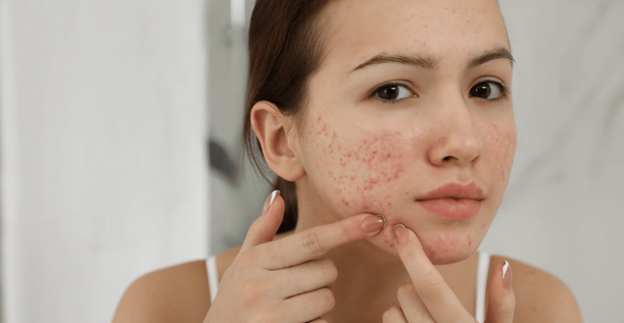
At some point, we all get pimples. It is usually more common in puberty because, at that time, hormone changes are at their peak. These can persist into adulthood. 85% of young people experience breakouts which means blemish prone skin is one of the most common skincare concerns.
One day your skin looks fine then suddenly the next day you may face blemishes without any warning. They can impact your confidence too. There are many factors like excess oil, hormones and stress which can lead to blemished skin.
In this article, we will explain the causes of these stubborn blemishes and how you can treat them. If you’re tired of trial and error, this article will help you understand what blemishes are and how to care for blemished skin the right way.
What is Blemish-Prone Skin?

Blemish prone skin is a type of skin that can easily develop pimples and comedones. It often looks uneven and oily. The reason is that in this type of skin sebaceous produce more sebum than in other skin types.
That excess oil mixes with dead skin cells and blocks pores. Because of your pores clogging, bacteria can grow which can cause inflammation. This situation leads to blemishes.
These are not occasional pimples. With this skin you can get breakouts more often. It won’t heal faster. If you have this type of skin, you can get blackheads, whiteheads or pimples. These issues appear more around the T-zone on the face.
You can also experience acne on the neck, shoulders, back and chest. This can vary from light acne to moderate or severe from person to person.
Blemished skin doesn’t just affect your skin, it can also affect your life. Because of this, you may have low self confidence which can be a stressful experience.
How Do Blemishes and Acne Develop? | Causes and Triggers
There are many complex factors that can lead to skin blemishes. They are developed in stages. Firstly, your skin produces more oil (sebum). The sebum is an oily substance which is secreted by sebaceous glands.
They play an important role in keeping hair and skin supple. Sometimes your skin produces more sebum which can be due to hormonal imbalance. This extra oil mixes with dead skin cells and gets trapped in your pores. Now your pores are blocked and bacteria can grow inside. This triggers inflammation.
This starts the process of having pimples or bumps. Over time, your clogged pores grow more bacteria and you may get blackheads, whiteheads or breakouts.
There are several reasons that can trigger this process:
● Excess oil: Too much oil can clog pores. Hormonal shifts often cause this.
● Dead skin: Not exfoliating let's dead cells build up and block pores.
● Bacteria: P. acnes gets trapped in pores and causes inflammation.
● Hormones: Puberty, periods, pregnancy and stress can trigger breakouts.
● Genetics: If acne runs in your family then you may have oily or sensitive skin.
● Skincare habits: Harsh products or skipping moisturizer can upset your skin.
● Diet: Sugar and dairy may lead to more oil and breakouts in some people.
● Pollution: Dirty air clogs pores if you don’t cleanse well.
● Stress: Stress messes with hormones and can make acne worse.
You should have the knowledge and understanding of these causes. So that you can help you break the cycle and choose the right routine for blemish prone skin.
Different Types of Acne Blemishes

There are many types of skin blemishes. All blemishes you see are not the same. Some sit on the surface; others go deep and cause pain. If you have the knowledge of what kind of blemishes you have, you can treat them better and in the right way.
Here are some different types of blemishes you should know:
|
Blackheads (Open Comedones) |
Got tiny black dots on your nose or chin? Those are blackheads. |
|
Whiteheads (Closed Comedones) |
This type looks like tiny white bumps. They form when a clogged pore stays shut and traps oil just under the skin. |
|
Pimples |
“Pimple” is a general word for red, inflamed blemishes. They often hurt and may contain pus. Pimples include both papules and pustules. |
|
Papules |
Small, red and swollen. These bumps don’t have pus. They feel firm and can be painful to touch. |
|
Pustules |
These look like papules but have yellowish pus inside. They form when inflammation gets worse. |
|
Nodules |
These are large, hard bumps under the skin. They form when a blocked pore becomes deeply inflamed. Nodules don’t always rise to the surface. |
|
Cysts |
Soft, painful lumps filled with pus. Cysts sit deep in the skin and can cause scarring. Cystic acne often needs medical treatment. |
|
Other Blemishes |
Once breakouts heal, they can leave dark spots or marks. These aren’t active acne but can stay for weeks or even months. |
Starting the right treatment depends on the understanding of which kind of blemishes you have. In this way you can avoid making it worse.
How to Treat Blemished Skin | Skincare Steps

If you want to treat your blemishes, the journey starts with a routine you can stick to. The goal isn’t to scrub your skin raw. It’s to balance oil, clear pores and calm irritation without making things worse.
So here we are sharing some simple steps so that you can manage your skin blemishes easily.
1. Cleanse – AM & PM
In every skincare routine, cleansing is the first step. It clears away oil, dirt, and makeup from your skin which is important to have healthy skin. For blemish-prone skin, you should use a gentle cleanser.
It should clean without drying or stripping your skin. Harsh products or over-washing can actually trigger more oil and breakouts.
You can try this: Renewing Gel Cleanser. This gentle formula uses enzymes to clean and lightly exfoliate. It leaves your skin feeling fresh, not tight.
2. Exfoliate – 2 to 3 times a week
Exfoliating is important to remove dead skin cells so that your pores won’t get clogged. It makes your skin smooth. Stick with something gentle. Harsh scrubs can do more harm than good, especially if your skin breaks out easily.
You can use Vitamin C Exfoliating Crystals. These let you control how much you use. They brighten and smooth without scratching or stinging.
3. Tone – Right after cleansing
Toner helps with oil control and tightens your pores. It also helps your skin soak in whatever comes next like serums or spot treatments. Go for one that’s light and calming, not drying.
You should try this reliable option: Revitalising Toning Mist. This mist feels fresh on the skin. It balances oil, adds a bit of hydration and calms redness without any stickiness.
4. Spot Treat – Only where you need it
If you see a breakout forming, spot treatments can bring it down fast. Don’t overdo it. Just dab a little on clean skin where the blemish is. No need to apply it all over your face.
You should go for Blemish Spot Remover. It works fast to shrink breakouts and ease redness. And it won’t dry out the rest of your skin.
5. Moisturize – every day, even if your skin is oily
If you have oily skin, people recommend you not use moisturizer. But you know what? That can make things worse. When your skin’s too dry, it produces more oil to make up for it. That extra oil? It can clog your pores.
You should use a light and oil-free moisturizer so that your skin remains steady. When your skin is hydrated, it heals faster and won’t get irritated after a breakout.
Buy moisturizer which has calming ingredients. You want your skin to feel comfortable, not smothered.
6. SPF – every morning
Sunscreen is not just for wearing on sunny days or to treat sunburn. If you’re experiencing acne or marks, the sun exposure can make it worse.
UV rays make dark spots darker. They also mess with healing and cause redness. Even on cloudy days, SPF makes a difference.
Go with one that says “non-comedogenic” so it won’t block your pores. Something light that sinks in fast is all you need. It’s one small step but it helps your skin a lot over time.
5 Tips to Help Fade Acne Marks
You successfully treated the breakouts but your acne marks remain? Don’t worry. They leave, but it can take some time. These dark spots can stick around for a long time if you don’t manage them with the right solutions.
Here’s what actually helps:
● Stop picking: It’s not easy, but picking makes it worse. You’re just pushing stuff deeper and making healing harder. It almost always leaves a mark. Just don’t touch it.
● Use sunscreen: You should wear sunscreen even if it is not sunny outside. Put on sunscreen every morning. Nothing fancy, just something that doesn’t clog your pores.
● Exfoliate gently: You don’t need to scrub your face raw. Just something light, two or three times a week, to clear dead skin. That helps marks fade over time.
● Moisturize: Dry skin takes time and doesn’t heal well. Your skin needs moisturizer no matter if you have oily or dry skin. Use something light that won’t block pores. It helps more than you think.
● Take care of your body too: This part matters. Bad sleep, stress, junk food; it all shows up on your face. Try to eat okay, drink water and sleep when you can.
That’s it. Nothing crazy and not too many things to do. Just simple steps you can easily add in your skincare routine.
Frequently Asked Questions
Q: How do I take care of dry, blemish-prone skin?
Ans: Start simple. You should try a gentle cleanser and a good moisturizer. Skip anything harsh. Always use SPF in the morning. That’s it.
Q: Is it okay to pop pimples?
Ans: No, you should never pop your pimples. It pushes bacteria deeper and can leave a scar. Use a spot treatment and leave it alone.
Q: Do genetics have anything to do with breakouts?
Ans: Yes. Genetics can be a reason for breakouts. If your skin gets oily fast or reacts easily, that can be because your family has it. Genetics affect how your skin handles bacteria too.
Q: Can makeup cause more blemishes?
Ans: It can, especially if it’s heavy or clogs pores. Go for non-comedogenic makeup and never sleep with it on. Always wash it off at night.
Conclusion
Blemish-prone skin doesn’t need a tough routine and love. It needs care. Breakouts usually have a cause. Figuring that out is the first step.
A basic routine you can stick to helps more than you think. The right habits and products, used daily can calm things down.
No skin is the same. But one thing that works across the board? Being gentle and consistent. Just keep your routine simple. By that time your skin will show progress.



Share:
Must-Have Targeted Treatments: Vitamin C Serums & Pink Clay Masks
What Does Vitamin C Do for Your Skin? Best Vitamin C Cream in Australia